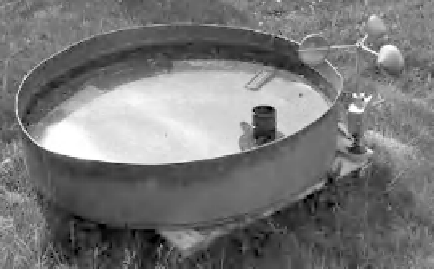Geoscience Reference
In-Depth Information
Figure 7.11
US Weather
Bureau '
Class A
' pan (From
Illinois State Water Survey
http://www.isws.illinois.edu/
atmos/statecli/Instruments/
panevap.jpg.)
0.05 m beneath the pan. Water is added to the pan as needed so that the water level
is always 0.05-0.075 m below the rim of the pan.
The measurements provided by evaporation pans are usually significantly
greater than the evaporation from nearby surfaces such as crops and lakes. This is
mainly because the energy balance of the pan is not representative. Some of the
energy for evaporation comes from radiant energy incident on the sides of the
pan, conduction through the sides or bottom of the pan, and/or energy transferred
from the air as it blows over the (usually cooler) water surface. For this reason
empirical correction factors, called
pan coefficients
, are used to correct the
measured evaporation rates downward to give a better estimate of the evaporation
rates for nearby vegetation, soil, or water surfaces. Pan coefficients can be in the
range 0.3 to 1.0 but are more typically in the range 0.65 to 0.85. Their value depends
on wind speed, relative humidity and where the pan is located, relative to the area
for which estimates are required, see Chapter 23. If, for example, evaporation
estimates are sought for an irrigated grass crop located in a dry landscape, the crop
factor appropriate for a pan located within the cropped area is closer to unity than
the pan factor for a pan located at the edge of the crop that is exposed to less humid
air from the surrounding dry area.
Watersheds and lakes
Evaporation has been inferred from the water balance of watersheds and lakes but
this is difficult to do with high accuracy because it is often deduced as a compara-
tively small residual in a water balance in which other terms dominate. Although
errors in measured runoff can be just a few percent, the errors in estimating area-
average precipitation and water storage can be significantly higher, say 5-15%
because of the sampling errors which can be significant over large areas, see
Chapter 12. In addition, unmeasured groundwater leakage is a systematic error
that is hard to estimate. As a result, errors in estimates of evaporation made from
the water balance of catchments and lakes may be as high as 20-30%.
However, comparative studies of the water balance of carefully selected and
well-maintained
paired catchment
s have given definitive evidence of evaporation





